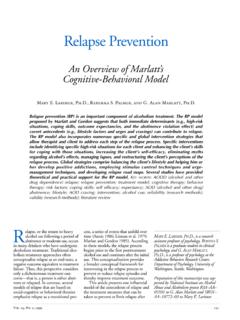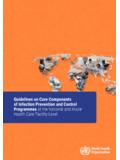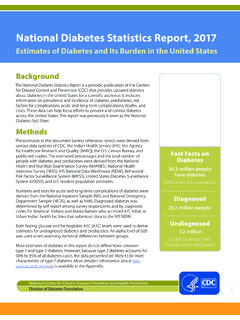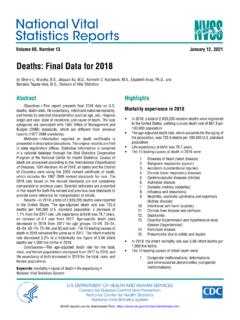Transcription of FOOD AND AGRICULTURE ORGANIZATION WORLD …
1 FOOD AND AGRICULTURE ORGANIZATION WORLD HEALTH ORGANIZATION . OF THE UNITED NATIONS. ASSURING FOOD SAFETY. AND QUALITY: GUIDELINES FOR STRENGTHENING national . FOOD control SYSTEMS. Joint FAO/WHO Publication TABLE OF CONTENTS. 1. PREAMBLE 1. 2. INTRODUCTION 2. 3. IMPORTANT FOOD ISSUES 3. Food Safety, Quality and Consumer Protection 3. Global Considerations 4. (a) International Trade 4. (b) Codex Alimentarius Commission 4. (c) SPS and TBT Agreements 4. 4. ELEMENTS OF A national FOOD control SYSTEM 6. Objectives 6. Scope 6. Building Blocks 6. (a) Food Law and Regulations 6. (b) Food control Management 7. (c) Inspection Services 7.
2 (d) Laboratory Services: Food Monitoring and Epidemiological Data 8. (e) Information, Education, Communication and Training 9. 5. STRENGTHENING national FOOD control SYSTEMS 10. Principles of Food control : Issues for Consideration 10. (a) Integrated farm-to-table concept 10. (b) Risk Analysis 11. (c) Transparency 11. (d) Regulatory Impact Assessment 11. Developing a national Food control Strategy 12. (a) Collection of Information 12. (b) Development of Strategy 12. Strengthening Organizational Structures for national Food control Systems 13. (a) Multiple Agency System 13. (b) Single Agency System 15. (c) Integrated System 15.
3 Funding national Food control Systems 16. 6. SPECIFIC ISSUES OF DEVELOPING COUNTRIES 17. Food Systems 17. Food Processing Industry 17. Street Foods 17. Food control Infrastructure and Resources 20. Technical Assistance: Role of International Agencies 20. Page iii ANNEX 1. Glossary 20. ANNEX 2. Addresses and Key Contacts 23. ANNEX 3. Considerations of Food Safety and Consumer Protection 25. ANNEX 4. Understanding the Joint FAO/WHO Codex Alimentarius Commission 29. ANNEX 5. Introducing the WTO SPS and TBT Agreements 36. ANNEX 6. Guidelines for Developing a national Food Law 54. ANNEX 7. Introducing JECFA, JMPR, JEMRA, and GM Food Risk Assessment 58.
4 ANNEX 8. A Country Profile Collection of Information 63. ANNEX 9. Case Studies national Food control Systems 65. ANNEX 10. Selected Organizational Components of a national Food control Agency 70. ANNEX 11. Possible Activities to be Undertaken during the Establishment of a national Food control Agency 73. Page iv 1. PREAMBLE. Effective national food control systems are essential to protect the health and safety of domestic consumers. They are also critical in enabling countries to assure the safety and quality of their foods entering international trade and to ensure that imported foods conform to national requirements.
5 The new global environment for food trade places considerable obligations on both importing and exporting countries to strengthen their food control systems and to implement and enforce risk-based food control strategies. Consumers are taking unprecedented interest in the way food is produced, processed and marketed, and are increasingly calling for their Governments to accept greater responsibility for food safety and consumer protection. The Food and AGRICULTURE ORGANIZATION of the United Nations (FAO) and the WORLD Health ORGANIZATION (WHO) have a strong interest in promoting national food control systems that are based upon scientific principles and guidelines, and which address all sectors of the food chain.
6 This is particularly important for developing countries as they seek to achieve improved food safety, quality and nutrition, but will require a high level of political and policy commitment. In many countries, effective food control is undermined by the existence of fragmented legislation, multiple jurisdictions, and weaknesses in surveillance, monitoring and enforcement. These guidelines seek to provide advice to national authorities on strategies to strengthen food control systems to protect public health, prevent fraud and deception, avoid food adulteration and facilitate trade. They will enable authorities to choose the most suitable options for their food control systems in terms of legislation, infrastructure and enforcement mechanisms.
7 The document delineates the overarching principles of food control systems, and provides examples of possible infrastructures and approaches for national systems. The target users of these Guidelines are national authorities concerned with ensuring food safety and quality in the interests of public health and consumer protection. The Guidelines will also be of assistance to a range of other stakeholders including consumer groups, industry and trade organizations, farmer groups and any other groups or associations that influence national policy in this area. Page 1. 2. INTRODUCTION. The publication Assuring Food Safety and Quality: Guidelines for Strengthening national Food control Systems was prepared to enable national authorities, particularly in developing countries, to improve their food control systems.
8 These Guidelines replace the earlier FAO/WHO publication Guidelines for Developing an Effective national Food control System (1976) - FAO Food control Series No. 1; WHO Food control No. 1. For over 25 years this publication has been the definitive reference for developing countries in planning, organizing, and implementing their national food control programmes. Much has changed in the intervening period. There have been advances in the control of foodborne hazards as well as improvements in food inspection and surveillance systems. Globalization of the food supply chain, the increasing importance of the Codex Alimentarius Commission, and the obligations emerging from the WORLD Trade ORGANIZATION (WTO).
9 Agreements have resulted in unprecedented interest in the development of food standards and regulations, and the strengthening of food control infrastructure at the country level. The challenges for food control authorities include: Increasing burden of foodborne illness and new and emerging foodborne hazards;. Rapidly changing technologies in food production, processing and marketing;. Developing science-based food control systems with a focus on consumer protection;. International food trade and need for harmonization of food safety and quality standards;. Changes in lifestyles, including rapid urbanization; and Growing consumer awareness of food safety and quality issues and increasing demand for better information.
10 Globally, the incidence of foodborne diseases is increasing and international food trade is disrupted by frequent disputes over food safety and quality requirements. Many food control systems need to be revised and strengthened if improvements are to be realized. It has never been more important for developing countries to implement and enforce a food control system based on the modern concept of risk assessment. These Guidelines provide important information on the principles and practices of food control and the trend away from a merely punitive to a preventive approach to food control . Responsibility for food control in most countries is shared between different agencies or ministries.
















